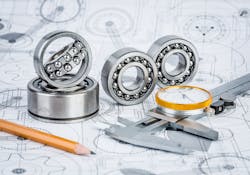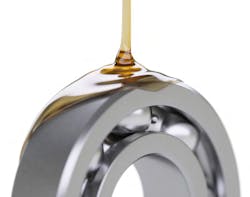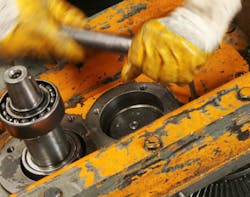Tips on How to Protect and Maintain Your Bearings
Bearings are some of the sturdiest and most reliable components for industrial applications. When maintained properly, roller, ball, and other types of bearings commonly outlive the equipment in which they are installed.
The key to preventing failure and maximizing bearing longevity is proper maintenance. While some bearings fulfill their natural life spans and eventually fail due to material fatigue, most bearing failures are caused by preventable conditions. Bearing failure can have a critical impact on equipment, necessitating potentially extensive repairs, downtime, and, in some cases, compromising user safety.
Taking the necessary precautions to maintain bearings not only maximizes their efficiency and longevity but also prevents costly system failure.
In this guide, you can explore the most effective ways to keep bearings working at their maximum capacity and avoid the failures that can come with inadequate maintenance.
Handling and Storage Guidelines
Proper maintenance can considerably minimize wear on bearings. The most significant sources of bearing wear include the invasion of foreign particles, inadequate lubrication, lubrication deterioration, and rolling/sliding surface corrosion. The following basic guidelines help to contribute to ensuring the longest life and best performance from your bearings systems.
Adequate Lubrication
Proper lubrication is perhaps the most important factor in maintaining bearings. The correct lubricant matches the speed, load, and temperature of the application. It must also be utilized in the correct quantity, as too much or too little lubrication can cause conditions that hasten wear and increase the likelihood of breakdowns.
Bearings Cleanliness
Accumulation of dirt particles accelerates the process of abrasion, which ultimately weakens bearings; keeping bearings clean will greatly help to decelerate the wear process.
Environmental Conditions
Bearings must be kept free from substances that interfere with their operation. In addition to dirt particles, bearings should be kept away from moisture, dust, and any corrosive substances that could affect their performance.
Correct Dimensions and Finish
Bearings that are in poor contact with the bearing seat or have out-of-square shoulder housings due to incorrect dimensions can cause misalignment of the bearing ring. The wrong finish can also increase stress on load zones. Both of these conditions can lead to overloads and system failure.
Use of Correct Tools
During both installation and maintenance procedures, it is essential to use the correct tools when mounting and dismounting bearings. All toolsets should reflect the size requirements needed, as bearings can be damaged or distorted while being handled with the wrong equipment. A damaged bearing will fatigue quickly and increase the risk of premature failure.
Prevent Corrosion
Bearings experience corrosion by coming into contact with destructive chemicals or electromechanical reactions in their environments. If corrosive agents or water reach the inside of bearings and lubricants cannot effectively counteract them, rust can form. Corrosive elements can also be introduced when installers do not clean their hands effectively prior to handling bearings. Always working with clean hands or gloves will help prevent this.
Proper Installation
Bearings that have been mounted incorrectly, used under improper operating conditions, or not used for their intended purpose can be subject to uneven wear. These factors are determined during the design phase to ensure the longest possible service life.
Protection by Individual Bearing Type
Since bearings are used in such a wide array of applications and settings, the best methods of fighting against fatigue and wear vary by type and use of bearing. From high contamination environments, such as mining, to settings with elements, such as electric current, each bearing has unique requirements to help reach maximum longevity and avoid breakdowns.
Ball Bearings
Ball bearings cover a diverse array of bearing types and applications. They can support high loads and work with high precision in some of the harshest work environments. For environments with high levels of contaminants, it is vital to ensure the correct levels of lubrication, along with sealing whenever necessary.
Roller Bearings
Like ball bearings, roller bearings are available in a number of different types, including tapered, cylindrical, and spherical. Proper lubrication is essential in roller bearings; too much or too little lubricant will result in excessive wear. Check for proper lubrication viscosity to counteract the heat damage that can result from too little lubrication, or the slippage that can occur from too much lubrication.
Mounted Bearings
Used for all varieties of industrial purposes, these bearings rely on proper mounting practices to ensure they are performing optimally. If bearings are improperly mounted, they may be subject to an increase in foreign matter during operation. Damage can occur during the mounting process itself as well, setting the scene for premature failure. Proper mounting at the beginning will help to eliminate these potential issues.
Oil Seals
Sealing elements play an important role in extending bearing longevity; by closing spaces between the stationary and moving components in mechanical systems, they help to prevent the escape or leaking of lubricant. They also prevent contaminating elements from entering and negatively affecting bearings, which is particularly important in severe industrial environments where contamination is common.
Roller/Leaf Chain
Bearings are an integral part of roller and leaf chains. To maintain bearings in these settings, it is important to measure the chains for wear. As roller and leaf chains gradually elongate over time, they must be measured to ensure that the pitch length has not increased by more than 2% — chains with elongations of 3% or more need to be replaced immediately.
Cam Follower and Yoke Rollers
Proper lubrication is the key to maintaining cam followers and yoke roller bearings. Although they generally require little maintenance, each type of bearing should be regularly relubricated to fulfill its maximum service life. The conditions of operation will determine how often relubrication is needed; low speeds, light loads, and clean surroundings will limit the number of treatments necessary while high speeds, high temperatures, and multiple contaminants will require frequent relubrication.
Rod Ends and Spherical Bushings
Relubrication plays an essential role in maintaining rod ends and spherical bushings, as well. These bearings have a steel/steel sliding contact surface combination and are often employed in applications with heavy static loads, shock loads, or alternating direction loads. In order to achieve the heavy-duty capabilities of rod ends and spherical bushings while keeping wear at a minimum, keep a regular relubrication schedule.
Linear Motion
While there are many different types of linear motion bearings, all of them require regular maintenance in order to operate at optimal levels. They can be relatively low in cost, but unlike many bearings, their lifespans often do not outlast their relubrication cycles. These bearings require regular inspections and maintenance schedules to recognize potential problems and replace failing bearings before serious issues occur.
Bearing Accessories
Proper bearing maintenance will inevitably necessitate some replacement and repair, requiring accessories that provide an exact fit to the associated application. Some of the most commonly ordered accessories include lock nuts, adapter sleeves, and withdrawal sleeves, as well as seals and bearing housings. When properly mounted and installed, accessories will help bearings maintain full lifespans and function with excellent operational efficiency.
All Varieties of Bearing Solutions
Knowing the best maintenance options for your individual bearing application is the key to maximizing the lifespan of your equipment. At Emerson Bearing, we have over 50 years of experience in providing the best quality bearings and accessories available on the market. We also keep our customers well-educated about their bearing options. Our vast store of resources includes case studies, video tutorials, eBooks, and more, including an in-depth guide to how bearings fail and how to prevent it.
Founded in 1957, Emerson Bearing Boston specializes in bearings for niche markets nationwide. The company provides solutions to a variety of industries including aggregate, concrete, mining, machine tools, electric motor repair, marine, material handling, metal processing, packaging, food processing, paper converting, printing, wind/power generation, recreation, heavy construction, robotics, automation, transportation, wood products, wastewater treatment, pump, compressor, and oil field. For more information, visit www.emersonbearing.com or call (800) 225-4587.





